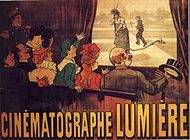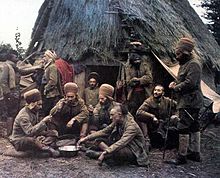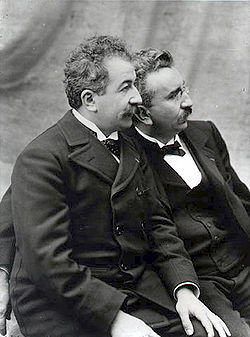- Auguste and Louis Lumière
-
The Lumière Brothers
Les frères LumièreAuguste Lumière (left) and Louis Lumière (right)
Place of birth Besançon, France Auguste Auguste Marie Louis Nicolas Lumière
October 19, 1862
April 10, 1954 (aged 91) (Lyon, France)Louis Louis Jean Lumière
October 5, 1864
June 6, 1948 (aged 83) (Bandol, French Riviera)Occupation Filmmakers Education La Martiniere Lyon Parents Claude-Antoine Lumière (1840–1895) Awards Elliott Cresson Medal (1909) The Lumière (pronounced: [lymjɛːʁ]) brothers, Auguste Marie Louis Nicolas ([ogyst maʁi lwi nikɔla]) (19 October 1862, Besançon, France – 10 April 1954, Lyon) and Louis Jean ([lwi ʒɑ̃]) (5 October 1864, Besançon, France – 6 June 1948, Bandol),[1][2] were among the earliest filmmakers in history. (Appropriately, "lumière" translates as "light" in English.)
Asteroid 775 Lumière is named in their honour.
Contents
History
The Lumière brothers were born in Besançon, France, in 1862 and 1864, and moved to Lyon in 1870, where both attended La Martiniere, the largest technical school in Lyon.[3] Their father, Claude-Antoine Lumière (1840–1911), ran a photographic firm and both brothers worked for him: Louis as a physicist and Auguste as a manager. Louis had made some improvements to the still-photograph process, the most notable being the dry-plate process, which was a major step towards moving images.
It was not until their father retired in 1892 that the brothers began to create moving pictures. They patented a number of significant processes leading up to their film camera, most notably film perforations (originally implemented by Emile Reynaud) as a means of advancing the film through the camera and projector. The cinématographe itself was patented on 13 February 1895 and the first footage ever to be recorded using it was recorded on March 19, 1895. This first film shows workers leaving the Lumière factory.
First film screenings
The Lumières held their first private screening of projected motion pictures in 1895.[4] Their first public screening of films at which admission was charged was held on December 28, 1895, at Salon Indien du Grand Café in Paris. This history-making presentation featured ten short films, including their first film, Sortie des Usines Lumière à Lyon (Workers Leaving the Lumière Factory).[5] Each film is 17 meters long, which, when hand cranked through a projector, runs approximately 50 seconds.
 The world's first film poster, for 1895's L'Arroseur arrosé
The world's first film poster, for 1895's L'Arroseur arrosé
It is believed their first film was actually recorded that same year (1895)[6] with Léon Bouly's cinématographe device, which was patented the previous year. The cinématographe — a three-in-one device that could record, develop, and project motion pictures — was further developed by the Lumières.
The public debut at the Grand Café came a few months later and consisted of the following ten short films (in order of presentation):[1]
- La Sortie de l'Usine Lumière à Lyon (literally, "the exit from the Lumière factory in Lyon", or, under its more common English title, Workers Leaving the Lumiere Factory), 46 seconds
- La Voltige ("Horse Trick Riders"), 46 seconds
- La Pêche aux poissons rouges ("fishing for goldfish"), 42 seconds
- Le Débarquement du Congrès de Photographie à Lyon ("the disembarkment of the Congress of Photographers in Lyon"), 48 seconds
- Les Forgerons ("Blacksmiths"), 49 seconds
- Le Jardinier (l'Arroseur Arrosé) ("The Gardener," or "The Sprinkler Sprinkled"), 49 seconds
- Repas de bébé ("Baby's Breakfast" (lit. "baby's meal")), 41 seconds
- Le Saut à la couverture ("Jumping Onto the Blanket"), 41 seconds
- La Place des Cordeliers à Lyon ("Cordeliers Square in Lyon"--a street scene), 44 seconds
- La Mer (Baignade en mer) ("the sea [bathing in the sea]"), 38 seconds
The Lumières went on tour with the cinématographe in 1896, visiting Bombay, London, Montreal,New York and Buenos Aires.
The moving images had an immediate and significant influence on popular culture with L'Arrivée d'un Train en Gare de la Ciotat (literally, "the arrival of a train at La Ciotat", but more commonly known as Arrival of a Train at a Station) and Carmaux, défournage du coke (Drawing out the coke). Their actuality films, or actualités, are often cited as the first, primitive documentaries. They also made the first steps towards comedy film with the slapstick of L'Arroseur Arrosé.
Early colour photography
 Autochrome color picture by Jean-Baptiste Tournassoud of North-African soldiers, Oise, France, 1917.link
Autochrome color picture by Jean-Baptiste Tournassoud of North-African soldiers, Oise, France, 1917.link Main article: Autochrome Lumière
Main article: Autochrome LumièreThe brothers stated that "the cinema is an invention without any future" and declined to sell their camera to other filmmakers such as Georges Méliès. This made many film makers upset. Consequently, their role in the history of film was exceedingly brief. They turned their attentions to colour photography and in 1903 they patented a colour photography process, the "Autochrome Lumière", launched on the market in 1907. Throughout much of the 20th century, the Lumière company was a major producer of photographic products in Europe, but the brand name, Lumière, disappeared from the marketplace following its merger with Ilford.
The Lumières also developed other products such as a loudspeaker, "Lumière tulle gras" (a dressing to heal burns) and the homonoid forceps (a medical tool).[citation needed]
Other early cinematographers
The Lumière Brothers were not the only ones to claim the title of the first cinematographers. The scientific chronophotography devices developed by Eadweard Muybridge, Étienne-Jules Marey and Ottomar Anschütz in the 1880s were able to produce moving photographs, as was Thomas Edison's Kinetoscope, premiered in 1891. Since 1892, the projected drawings of Émile Reynaud's Théâtre Optique were attracting Paris crowds to the Museé Grevin. Louis Le Prince had been shooting moving picture sequences on paper film as soon as 1888, but had never performed a public demonstration. Polish inventor, Kazimierz Prószyński had built his camera and projecting device, called Pleograph, in 1894. Max and Emil Skladanowsky, inventors of the Bioskope, had offered projected moving images to a paying public one month earlier (November 1, 1895, in Berlin). Nevertheless, film historians consider the Grand Café screening to be the true birth of the cinema as a commercial medium, because the Skladanowsky brothers' screening used an extremely impractical dual system motion picture projector that was immediately supplanted by the Lumiere cinematographe.
Although the Lumière brothers were not the first inventors to develop techniques to create motion pictures, they are often credited as one of the first inventors of Cinema as a mass medium, and are among the first who understood how to use it. By comparison, it is argued that Thomas Edison may have meant his invention as entertainment for rich people, not as a movie to be seen in public.[7]
See also
References
- ^ "Louis Lumière, 83, A Screen Pioneer. Credited in France With The Invention of Motion Picture.". New York Times. 7 June 1948. http://select.nytimes.com/gst/abstract.html?res=F50715FF3A5F167B93C5A9178DD85F4C8485F9. Retrieved 2008-04-29.
- ^ "Died.". Time (magazine). 14 June 1948. http://www.time.com/time/magazine/article/0,9171,854930,00.html. Retrieved 2008-04-29. "Louis Lumière, 83, wealthy motion-picture and color-photography pioneer, whom (with his brother Auguste) Europeans generally credit with inventing the cinema; of a heart ailment; in Bandol, France."
- ^ Gina De Angelis (2003). Motion Pictures. The Oliver Press. ISBN 9781881508786. http://books.google.com/books?id=daHmkclqERYC&pg=PA34&dq=Lumi%C3%A8re+Besan%C3%A7on+Lyon&lr=&as_brr=3&as_pt=ALLTYPES&ei=eqdfSaiYK4PAlQTF4tj7BQ#PPA34,M1.
- ^ Chardère (1985), p.71. This first screening on March 22, 1895 took place in Paris, at the "Society for the Development of the National Industry", in front of an audience of 200 people – among which Léon Gaumont, then director of the Comptoir de la photographie. The main focus of this conference by Louis Lumière were the recent developments in the photograph industry, mainly the research on polychromy (color photography). It was much to Lumière's surprise that the moving black-and-white images retained more attention than the colored stills photographs.
- ^ "La première séance publique payante", Institut Lumière
- ^ Chardère (1987), p.70: The date of the recording of their first film is in dispute. In an interview with Georges Sadoul given in 1948, Louis Lumière tells that he shot the film in August 1894. This is questioned by historians (Sadoul, Pinel, Chardère) who consider that a functional Lumière camera didn't exist before the end of 1894, and that their first film was recorded March 19th 1895, and then publicly projected March 22nd at the Société d'encouragement pour l'industrie nationale in Paris.
- ^ Michaël Abecassis, Revue de cinématrographie, 12, 2005, University of Rouen ed.
Further reading
- Chardère, B.; Borgé, G. and M. (1985). Les Lumière, Paris: Bibliothèque des Arts. ISBN 2-85047-068-6 (Language: French)
- Chardère, B. (1995). Les images des Lumière, Paris: Gallimard. ISBN 2-07-011462-7 (Language: French)
- Cook, David (2004). A History of Narrative Film (4th ed. ed.). New York: W. W. Norton. ISBN 0-393-97868-0.
- Rittaud-Hutinet, Jacques. (1985). Le cinéma des origines, Seyssel: Champ Vallon. ISBN 2-903528-43-8 (Language: French)
- Mast, Gerald; and Bruce F. Kawin (2006). A Short History of the Movies (9th ed. ed.). New York: Pearson Longman. ISBN 0-321-26232-8.
External links
- Société d'encouragement pour l'industrie nationale
- Louis Lumière at Who's Who of Victorian Cinema
- Auguste Lumière at Who's Who of Victorian Cinema
- The films shown at the first public screening (Quicktime format) — December 28, 1895. Also includes a program for the event.
- Le musée Lumière — Lumière Museum
- autochrome color still of the Lumiere Brothers , 1907
Films by Auguste and Louis Lumière 1895 La Sortie de l'usine Lumière à Lyon – La Voltige – La Pêche aux poissons rouges – Le Débarquement du congrès de photographie à Lyon – Les Forgerons – L'Arroseur Arrosé – Le Repas de bébé – Le Saut à la couverture – La Place des Cordeliers à Lyon – La Mer (Baignade en mer) –1896 Cinema of France Actors · Directors · Cinematographers · Editors · Films A-Z · Producers · Score composers · Screenwriters · Film festivals
Films by year: 1892–1909 · 1910 · 1911 · 1912 · 1913 · 1914 · 1915 · 1916 · 1917 · 1918 · 1919 · 1920 · 1921 · 1922 · 1923 · 1924 · 1925 · 1926 · 1927 · 1928 · 1929 · 1930 · 1931 · 1932 · 1933 · 1934 · 1935 · 1936 · 1937 · 1938 · 1939 · 1940 · 1941 · 1942 · 1943 · 1944 · 1945 · 1946 · 1947 · 1948 · 1949 · 1950 · 1951 · 1952 · 1953 · 1954 · 1955 · 1956 · 1957 · 1958 · 1959 · 1960 · 1961 · 1962 · 1963 · 1964 · 1965 · 1966 · 1967 · 1968 · 1969 · 1970 · 1971 · 1972 · 1973 · 1974 · 1975 · 1976 · 1977 · 1978 · 1979 · 1980 · 1981 · 1982 · 1983 · 1984 · 1985 · 1986 · 1987 · 1988 · 1989 · 1990 · 1991 · 1992 · 1993 · 1994 · 1995 · 1996 · 1997 · 1998 · 1999 · 2000 · 2001 · 2002 · 2003 · 2004 · 2005 · 2006 · 2007 · 2008 · 2009 · 2010 · 2011
Categories:- Color scientists
- Sibling duos
- French film directors
- French businesspeople
- French inventors
- Pioneers of photography
- Cinema pioneers
- History of film
- Cinema of France
- La Martiniere College
- 1895 films
- Members of the French Academy of Sciences
- People from Besançon
- Sibling filmmakers
Wikimedia Foundation. 2010.


